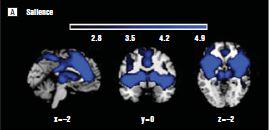While there have been many findings in the literature demonstrating that the brains of those with autism differ from non-autistic individuals, the results often do not agree. This study used neuroimaging techniques to examine the degree to which the level of brain connectivity was a distinguishing feature of autism. 
The study compared 20 rigorously diagnosed high-functioning autistic children (average age 10) with 20 controls who were matched by age, sex and IQ. Functional and anatomical MRIs were obtained with the primary measure of interest being the level of functional connectivity (ie how closely wired these regions were) within 10 large scale brain networks. A classification algorithm was then applied to test whether the connectivity data within a network could successfully classify a subject as autistic or non-autistic.
A higher level of functional connectivity was found in the autistic versus the control group in several functional brain networks including the salience, posterior default mode network, frontotemporal, motor, and visual. The salience network, which is comprised of the anterior insular cortex and dorsal anterior cingulate gyrus, is involved in functions such as attention, interoception, reward processing, and subjective awareness. This network was found to be most discriminating of autism with a classification accuracy of 78% (75% sensitivity, 80% specificity).
The authors concluded that hyperconnectivity of major brain networks is a central neurobiological component of autism, at least in children. A hyperconnected salience network in particular may be a distinguishing feature of autistic spectrum disorder and may be useful as a potential biomarker for autism.
The authors speculated that brain “network isolation” might result in some of the core symptoms of autism in that these systems may have more limited interaction between them. These findings are in contrast to the network HYPOconnectivity that has been found previously, but these studies tend to be with older samples and suggest the possibility of important developmental differences both before and after birth.
It is important to remember when hearing about promising sensitivity and specificity numbers based on an objective test that clinical utility generally rests not in distinguishing a disorder from a group of typically developing individuals but in distinguishing one disorder from another. This classification procedure is not ready for clinical use but may help pave the way for future procedures as diagnostic aids.
Reference
Uddin et al., Salience network-based classification and prediction of symptom severity in children with autism. Arch Gen Psychiatry 2013; June online first: e1-e11.
Tags: autism, brain connectivity

